- GCN/BACODINE POSITION NOTICE
TITLE: GCN/SWIFT NOTICE
NOTICE_DATE: Tue 18 Apr 06 03:06:33 UT
NOTICE_TYPE: Swift-BAT GRB Position
TRIGGER_NUM: 205851, Seg_Num: 0
GRB_RA: 236.420d {+15h 45m 41s} (J2000),
236.502d {+15h 46m 01s} (current),
235.765d {+15h 43m 04s} (1950)
GRB_DEC: -3.643d {-03d 38' 35"} (J2000),
-3.663d {-03d 39' 45"} (current),
-3.488d {-03d 29' 16"} (1950)
GRB_ERROR: 3.00 [arcmin radius, statistical only]
GRB_INTEN: 6599 [cnts] Image_Peak=295 [image_cnts]
TRIGGER_DUR: 1.024 [sec]
TRIGGER_INDEX: 147 E_range: 25-100 keV
BKG_INTEN: 37997 [cnts]
BKG_TIME: 11150.86 SOD {03:05:50.86} UT
BKG_DUR: 8 [sec]
GRB_DATE: 13843 TJD; 108 DOY; 06/04/18
GRB_TIME: 11168.20 SOD {03:06:08.20} UT
GRB_PHI: 94.95 [deg]
GRB_THETA: 31.21 [deg]
SOLN_STATUS: 0x3
RATE_SIGNIF: 28.93 [sigma]
IMAGE_SIGNIF: 10.80 [sigma]
MERIT_PARAMS: +1 +0 +0 +0 +2 +11 +0 +0 +85 +1
SUN_POSTN: 25.96d {+01h 43m 51s} +10.75d {+10d 44' 46"}
SUN_DIST: 148.91 [deg] Sun_angle= 10.0 [hr] (West of Sun)
MOON_POSTN: 258.57d {+17h 14m 17s} -28.16d {-28d 09' 44"}
MOON_DIST: 32.27 [deg]
MOON_ILLUM: 81 [%]
GAL_COORDS: 3.61, 37.93 [deg] galactic lon,lat of the burst (or transient)
ECL_COORDS: 234.99, 15.81 [deg] ecliptic lon,lat of the burst (or transient)
COMMENTS: SWIFT-BAT GRB Coordinates.
COMMENTS: This is a rate trigger.
COMMENTS: A point_source was found.
COMMENTS: This does not match any source in the on-board catalog.
COMMENTS: This does not match any source in the ground catalog.
COMMENTS: This is a GRB.
COMMENTS: This trigger occurred at longitude,latitude = 1.94,12.24 [deg].
- red DSS finding chart
ps-file

- GCN NOTICE
TITLE: GCN/SWIFT NOTICE
NOTICE_DATE: Tue 18 Apr 06 03:08:03 UT
NOTICE_TYPE: Swift-XRT Image
TRIGGER_NUM: 205851, Seg_Num: 0
GRB_RA: 236.4286d {+15h 45m 42.8s} (J2000),
236.5111d {+15h 46m 02.6s} (current),
235.7737d {+15h 43m 05.6s} (1950)
GRB_DEC: -3.6406d {-03d 38' 26.1"} (J2000),
-3.6600d {-03d 39' 35.8"} (current),
-3.4853d {-03d 29' 07.1"} (1950)
GRB_ERROR: 5.8 [arcsec, radius, statistical plus systematic]
GRB_INTEN: 27 [cnts]
IMG_START_DATE: 13843 TJD; 108 DOY; 06/04/18
IMG_START_TIME: 11246.17 SOD {03:07:26.17} UT, 78.0 [sec] since BAT Trigger Time
CENTROID_X: 325.19, raw= 325 [pixels]
CENTROID_Y: 294.57, raw= 295 [pixels]
ROLL: 75.09 [deg]
GAIN: 1
MODE: 2, Short Image mode
WAVEFORM: 134
EXPO_TIME: 0.10 [sec]
GRB_POS_XRT_Y: -9.95
GRB_POS_XRT_Z: 56.32
IMAGE_URL: sw00205851000msxps_rw.img
SUN_POSTN: 25.96d {+01h 43m 51s} +10.75d {+10d 44' 48"}
SUN_DIST: 148.90 [deg] Sun_angle= 10.0 [hr] (West of Sun)
MOON_POSTN: 258.59d {+17h 14m 21s} -28.16d {-28d 09' 49"}
MOON_DIST: 32.28 [deg]
MOON_ILLUM: 81 [%]
GAL_COORDS: 3.62, 37.92 [deg] galactic lon,lat of the burst
ECL_COORDS: 235.00, 15.81 [deg] ecliptic lon,lat of the burst
COMMENTS: SWIFT-XRT Image.

- GCN NOTICE
TITLE: GCN/SWIFT NOTICE
NOTICE_DATE: Tue 18 Apr 06 03:08:02 UT
NOTICE_TYPE: Swift-XRT Position
TRIGGER_NUM: 205851, Seg_Num: 0
GRB_RA: 236.4286d {+15h 45m 42.8s} (J2000),
236.5111d {+15h 46m 02.6s} (current),
235.7737d {+15h 43m 05.6s} (1950)
GRB_DEC: -3.6406d {-03d 38' 26.1"} (J2000),
-3.6600d {-03d 39' 35.8"} (current),
-3.4853d {-03d 29' 07.1"} (1950)
GRB_ERROR: 5.8 [arcsec radius, statistical plus systematic, 90% containment]
GRB_INTEN: 1.60e-08 [erg/cm2/sec]
GRB_SIGNIF: 5.19 [sigma]
IMG_START_DATE: 13843 TJD; 108 DOY; 06/04/18
IMG_START_TIME: 11246.17 SOD {03:07:26.17} UT, 78.0 [sec] since BAT Trigger Time
TAM[0-3]: 327.63 237.22 261.19 243.35
AMPLIFIER: 2
WAVEFORM: 134
SUN_POSTN: 25.96d {+01h 43m 51s} +10.75d {+10d 44' 48"}
SUN_DIST: 148.90 [deg] Sun_angle= 10.0 [hr] (West of Sun)
MOON_POSTN: 258.59d {+17h 14m 20s} -28.16d {-28d 09' 49"}
MOON_DIST: 32.28 [deg]
MOON_ILLUM: 81 [%]
GAL_COORDS: 3.62, 37.92 [deg] galactic lon,lat of the burst
ECL_COORDS: 235.00, 15.81 [deg] ecliptic lon,lat of the burst
COMMENTS: SWIFT-XRT Coordinates.
- GCN NOTICE
TITLE: GCN/SWIFT NOTICE
NOTICE_DATE: Tue 18 Apr 06 03:08:16 UT
NOTICE_TYPE: Swift-XRT Processed Image
TRIGGER_NUM: 205851, Seg_Num: 0
GRB_RA: 236.4286d {+15h 45m 42.8s} (J2000),
236.5111d {+15h 46m 02.6s} (current),
235.7737d {+15h 43m 05.6s} (1950)
GRB_DEC: -3.6406d {-03d 38' 26.1"} (J2000),
-3.6600d {-03d 39' 35.8"} (current),
-3.4853d {-03d 29' 07.1"} (1950)
GRB_ERROR: 5.8 [arcsec, radius, statistical plus systematic]
GRB_INTEN: 27 [cnts]
IMG_START_DATE: 13843 TJD; 108 DOY; 06/04/18
IMG_START_TIME: 11246.17 SOD {03:07:26.17} UT, 78.0 [sec] since BAT Trigger Time
CENTROID_X: 325.19, raw= 325 [pixels]
CENTROID_Y: 294.57, raw= 295 [pixels]
ROLL: 75.09 [deg]
GAIN: 1
MODE: 2, Short Image mode
WAVEFORM: 134
EXPO_TIME: 0.10 [sec]
GRB_POS_XRT_Y: -9.95
GRB_POS_XRT_Z: 56.32
IMAGE_URL: sw00205851000msxps_rw.img
SUN_POSTN: 25.96d {+01h 43m 51s} +10.75d {+10d 44' 48"}
SUN_DIST: 148.90 [deg] Sun_angle= 10.0 [hr] (West of Sun)
MOON_POSTN: 258.59d {+17h 14m 21s} -28.16d {-28d 09' 50"}
MOON_DIST: 32.28 [deg]
MOON_ILLUM: 81 [%]
GAL_COORDS: 3.62, 37.92 [deg] galactic lon,lat of the burst
ECL_COORDS: 235.00, 15.81 [deg] ecliptic lon,lat of the burst
COMMENTS: SWIFT-XRT Processed Image.

- GCN NOTICE
TITLE: GCN/SWIFT NOTICE
NOTICE_DATE: Tue 18 Apr 06 03:09:56 UT
NOTICE_TYPE: Swift-UVOT Source List
TRIGGER_NUM: 205851, Seg_Num: 0
POINT_RA: 236.441d {+15h 45m 46s} (J2000)
POINT_DEC: -3.633d {-03d 37' 59"} (J2000)
POINT_ROLL: 75.094d
IMG_START_DATE: 13843 TJD; 108 DOY; 06/04/18
IMG_START_TIME: 11255.52 SOD {03:07:35.52} UT, 87.3 [sec] since BAT Trigger Time
FILTER: 10, White
BKG_MEAN: 1.942
N_STARS: 48
X_OFFSET: 336 [pixels]
Y_OFFSET: 656 [pixels]
X_MAX: 1295 [pixels]
Y_MAX: 1615 [pixels]
DET_THRESH: 12
PHOTO_THRESH: 6
SL_URL: sw00205851000msufc0087.fits
SUN_POSTN: 25.96d {+01h 43m 51s} +10.75d {+10d 44' 49"}
SUN_DIST: 148.89 [deg] Sun_angle= 10.0 [hr] (West of Sun)
MOON_POSTN: 258.60d {+17h 14m 25s} -28.17d {-28d 09' 56"}
MOON_DIST: 32.29 [deg]
MOON_ILLUM: 81 [%]
GAL_COORDS: 3.63, 37.92 [deg] galactic lon,lat of the pointing direction
ECL_COORDS: 235.01, 15.82 [deg] ecliptic lon,lat of the pointing direction
COMMENTS: SWIFT-UVOT Source List.
- GCN NOTICE
TITLE: GCN/SWIFT NOTICE
NOTICE_DATE: Tue 18 Apr 06 03:10:56 UT
NOTICE_TYPE: Swift-UVOT Processed Source List
TRIGGER_NUM: 205851, Seg_Num: 0
POINT_RA: 236.441d {+15h 45m 46s} (J2000)
POINT_DEC: -3.633d {-03d 37' 59"} (J2000)
POINT_ROLL: 75.094d
IMG_START_DATE: 13843 TJD; 108 DOY; 06/04/18
IMG_START_TIME: 11255.52 SOD {03:07:35.52} UT, 87.3 [sec] since BAT Trigger Time
FILTER: 10, White
BKG_MEAN: 1.942
N_STARS: 48
X_OFFSET: 336 [pixels]
Y_OFFSET: 656 [pixels]
X_MAX: 1295 [pixels]
Y_MAX: 1615 [pixels]
DET_THRESH: 12
PHOTO_THRESH: 6
SL_URL: sw00205851000msufc0087.fits
SUN_POSTN: 25.97d {+01h 43m 52s} +10.75d {+10d 44' 50"}
SUN_DIST: 148.89 [deg] Sun_angle= 10.0 [hr] (West of Sun)
MOON_POSTN: 258.62d {+17h 14m 28s} -28.17d {-28d 09' 59"}
MOON_DIST: 32.30 [deg]
MOON_ILLUM: 81 [%]
GAL_COORDS: 3.63, 37.92 [deg] galactic lon,lat of the pointing direction
ECL_COORDS: 235.01, 15.82 [deg] ecliptic lon,lat of the pointing direction
COMMENTS: SWIFT-UVOT Processed Source List.
COMMENTS: All 4 attachments are included.
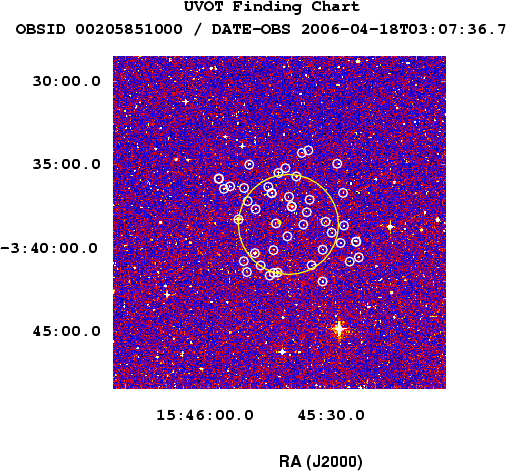
- GCN NOTICE
TITLE: GCN/SWIFT NOTICE
NOTICE_DATE: Tue 18 Apr 06 03:11:42 UT
NOTICE_TYPE: Swift-BAT GRB Lightcurve
TRIGGER_NUM: 205851, Seg_Num: 0
GRB_RA: 236.420d {+15h 45m 41s} (J2000),
236.502d {+15h 46m 01s} (current),
235.765d {+15h 43m 04s} (1950)
GRB_DEC: -3.643d {-03d 38' 35"} (J2000),
-3.663d {-03d 39' 45"} (current),
-3.488d {-03d 29' 16"} (1950)
GRB_DATE: 13843 TJD; 108 DOY; 06/04/18
GRB_TIME: 11168.20 SOD {03:06:08.20} UT
TRIGGER_INDEX: 147
GRB_PHI: 94.95 [deg]
GRB_THETA: 31.21 [deg]
DELTA_TIME: 25.00 [sec]
TRIGGER_DUR: 1.024 [sec]
SOLN_STATUS: 0x3
RATE_SIGNIF: 28.93 [sigma]
IMAGE_SIGNIF: 10.80 [sigma]
LC_URL: sw00205851000msb.lc
SUN_POSTN: 25.97d {+01h 43m 52s} +10.75d {+10d 44' 51"}
SUN_DIST: 148.91 [deg] Sun_angle= 10.0 [hr] (West of Sun)
MOON_POSTN: 258.62d {+17h 14m 30s} -28.17d {-28d 10' 01"}
MOON_DIST: 32.31 [deg]
MOON_ILLUM: 81 [%]
GAL_COORDS: 3.61, 37.93 [deg] galactic lon,lat of the burst (or transient)
ECL_COORDS: 234.99, 15.81 [deg] ecliptic lon,lat of the burst (or transient)
COMMENTS: SWIFT-BAT GRB Lightcurve.
COMMENTS:
COMMENTS: The next comments were copied from the BAT_POS Notice:
COMMENTS: This is a rate trigger.
COMMENTS: A point_source was found.
COMMENTS: This does not match any source in the on-board catalog.
COMMENTS: This does not match any source in the ground catalog.
COMMENTS: This is a GRB.
COMMENTS: This trigger occurred at longitude,latitude = 1.94,12.24 [deg].
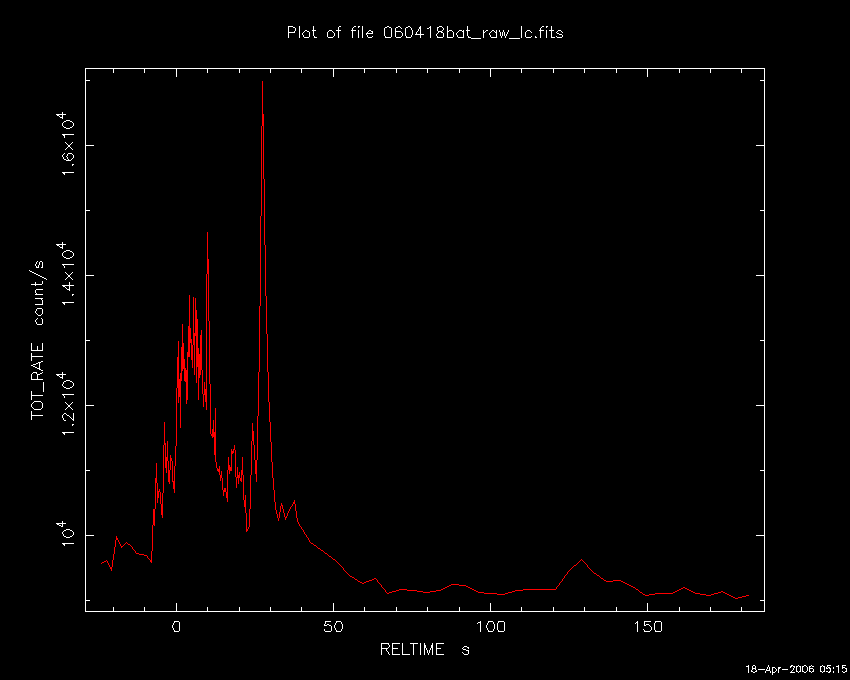
- GCN NOTICE
TITLE: GCN/SWIFT NOTICE
NOTICE_DATE: Tue 18 Apr 06 03:11:15 UT
NOTICE_TYPE: Swift-UVOT Image
TRIGGER_NUM: 205851, Seg_Num: 0
POINT_RA: 236.441d {+15h 45m 46s} (J2000)
POINT_DEC: -3.633d {-03d 37' 59"} (J2000)
ROLL: 75.094d
IMG_START_DATE: 13843 TJD; 108 DOY; 06/04/18
IMG_START_TIME: 11255.52 SOD {03:07:35.52} UT, 87.3 [sec] since BAT Trigger Time
FILTER: 10, White
EXPOSURE_ID: 167022456
X_OFFSET: 707 [pixels]
Y_OFFSET: 947 [pixels]
WIDTH: 160 [pixels]
HEIGHT: 160 [pixels]
X_GRB_POS: 867
Y_GRB_POS: 1107
BINNING_INDEX: 1
IM_URL: sw00205851000msuni0087.fits
SUN_POSTN: 25.97d {+01h 43m 52s} +10.75d {+10d 44' 50"}
SUN_DIST: 148.89 [deg] Sun_angle= 10.0 [hr] (West of Sun)
MOON_POSTN: 258.62d {+17h 14m 28s} -28.17d {-28d 10' 00"}
MOON_DIST: 32.30 [deg]
MOON_ILLUM: 81 [%]
GAL_COORDS: 3.63, 37.92 [deg] galactic lon,lat of the pointing direction
ECL_COORDS: 235.01, 15.82 [deg] ecliptic lon,lat of the pointing direction
COMMENTS: SWIFT-UVOT Image.
COMMENTS: The GRB Position came from the XRT Position Command.
COMMENTS: The image has 2x2 binning (compression).
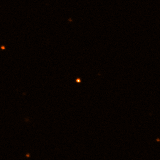
- GCN NOTICE
TITLE: GCN/SWIFT NOTICE
NOTICE_DATE: Tue 18 Apr 06 03:12:25 UT
NOTICE_TYPE: Swift-UVOT Processed Image
TRIGGER_NUM: 205851, Seg_Num: 0
POINT_RA: 236.441d {+15h 45m 46s} (J2000)
POINT_DEC: -3.633d {-03d 37' 59"} (J2000)
ROLL: 75.094d
IMG_START_DATE: 13843 TJD; 108 DOY; 06/04/18
IMG_START_TIME: 11255.52 SOD {03:07:35.52} UT, 87.3 [sec] since BAT Trigger Time
FILTER: 10, White
EXPOSURE_ID: 167022456
X_OFFSET: 707 [pixels]
Y_OFFSET: 947 [pixels]
WIDTH: 160 [pixels]
HEIGHT: 160 [pixels]
X_GRB_POS: 867
Y_GRB_POS: 1107
BINNING_INDEX: 1
IM_URL: sw00205851000msuni0087.fits
SUN_POSTN: 25.97d {+01h 43m 52s} +10.75d {+10d 44' 51"}
SUN_DIST: 148.89 [deg] Sun_angle= 10.0 [hr] (West of Sun)
MOON_POSTN: 258.63d {+17h 14m 31s} -28.17d {-28d 10' 04"}
MOON_DIST: 32.31 [deg]
MOON_ILLUM: 81 [%]
GAL_COORDS: 3.63, 37.92 [deg] galactic lon,lat of the pointing direction
ECL_COORDS: 235.01, 15.82 [deg] ecliptic lon,lat of the pointing direction
COMMENTS: SWIFT-UVOT Processed Image.
COMMENTS: The GRB Position came from the XRT Position Command.
COMMENTS: The image has 2x2 binning (compression).
COMMENTS: All 4 attachments are included.
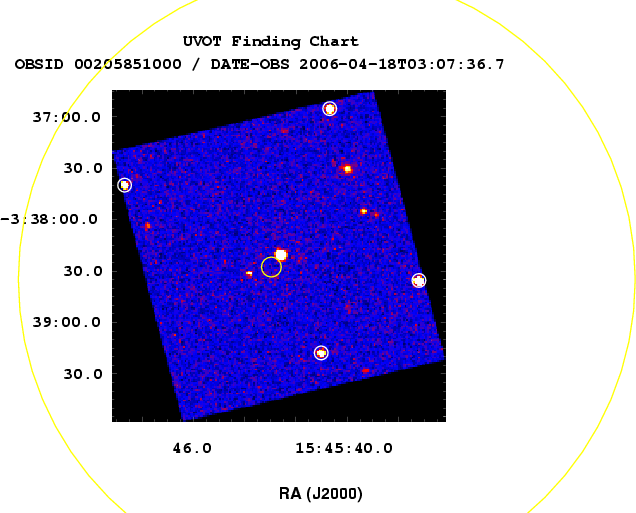
- GCN NOTICE
TITLE: GCN/SWIFT NOTICE
NOTICE_DATE: Tue 18 Apr 06 03:17:03 UT
NOTICE_TYPE: Swift-UVOT Source List
TRIGGER_NUM: 205851, Seg_Num: 0
POINT_RA: 236.443d {+15h 45m 46s} (J2000)
POINT_DEC: -3.634d {-03d 38' 01"} (J2000)
POINT_ROLL: 75.095d
IMG_START_DATE: 13843 TJD; 108 DOY; 06/04/18
IMG_START_TIME: 11360.87 SOD {03:09:20.87} UT, 192.7 [sec] since BAT Trigger Time
FILTER: 3, V
BKG_MEAN: 1.798
N_STARS: 72
X_OFFSET: 387 [pixels]
Y_OFFSET: 627 [pixels]
X_MAX: 1346 [pixels]
Y_MAX: 1586 [pixels]
DET_THRESH: 11
PHOTO_THRESH: 6
SL_URL: sw00205851000msufc0192.fits
SUN_POSTN: 25.97d {+01h 43m 53s} +10.75d {+10d 44' 56"}
SUN_DIST: 148.89 [deg] Sun_angle= 10.0 [hr] (West of Sun)
MOON_POSTN: 258.68d {+17h 14m 43s} -28.17d {-28d 10' 19"}
MOON_DIST: 32.34 [deg]
MOON_ILLUM: 81 [%]
GAL_COORDS: 3.64, 37.91 [deg] galactic lon,lat of the pointing direction
ECL_COORDS: 235.01, 15.82 [deg] ecliptic lon,lat of the pointing direction
COMMENTS: SWIFT-UVOT Source List.
- GCN NOTICE
TITLE: GCN/SWIFT NOTICE
NOTICE_DATE: Tue 18 Apr 06 03:17:49 UT
NOTICE_TYPE: Swift-UVOT Processed Source List
TRIGGER_NUM: 205851, Seg_Num: 0
POINT_RA: 236.443d {+15h 45m 46s} (J2000)
POINT_DEC: -3.634d {-03d 38' 01"} (J2000)
POINT_ROLL: 75.095d
IMG_START_DATE: 13843 TJD; 108 DOY; 06/04/18
IMG_START_TIME: 11360.87 SOD {03:09:20.87} UT, 192.7 [sec] since BAT Trigger Time
FILTER: 3, V
BKG_MEAN: 1.798
N_STARS: 72
X_OFFSET: 387 [pixels]
Y_OFFSET: 627 [pixels]
X_MAX: 1346 [pixels]
Y_MAX: 1586 [pixels]
DET_THRESH: 11
PHOTO_THRESH: 6
SL_URL: sw00205851000msufc0192.fits
SUN_POSTN: 25.97d {+01h 43m 53s} +10.75d {+10d 44' 56"}
SUN_DIST: 148.89 [deg] Sun_angle= 10.0 [hr] (West of Sun)
MOON_POSTN: 258.69d {+17h 14m 45s} -28.17d {-28d 10' 22"}
MOON_DIST: 32.35 [deg]
MOON_ILLUM: 81 [%]
GAL_COORDS: 3.64, 37.91 [deg] galactic lon,lat of the pointing direction
ECL_COORDS: 235.01, 15.82 [deg] ecliptic lon,lat of the pointing direction
COMMENTS: SWIFT-UVOT Processed Source List.
COMMENTS: All 4 attachments are included.
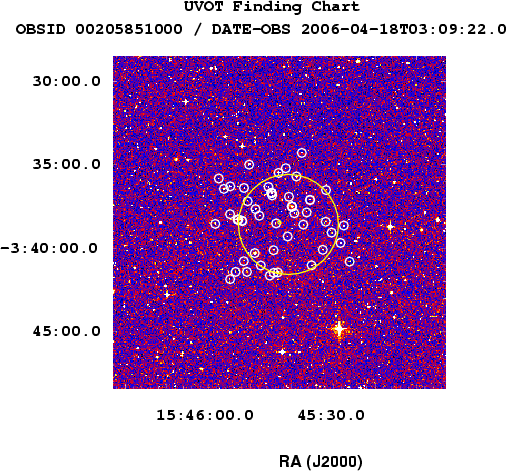
- GCN NOTICE
TITLE: GCN/SWIFT NOTICE
NOTICE_DATE: Tue 18 Apr 06 03:18:28 UT
NOTICE_TYPE: Swift-UVOT Image
TRIGGER_NUM: 205851, Seg_Num: 0
POINT_RA: 236.443d {+15h 45m 46s} (J2000)
POINT_DEC: -3.634d {-03d 38' 01"} (J2000)
ROLL: 75.095d
IMG_START_DATE: 13843 TJD; 108 DOY; 06/04/18
IMG_START_TIME: 11360.87 SOD {03:09:20.87} UT, 192.7 [sec] since BAT Trigger Time
FILTER: 3, V
EXPOSURE_ID: 167022562
X_OFFSET: 707 [pixels]
Y_OFFSET: 947 [pixels]
WIDTH: 160 [pixels]
HEIGHT: 160 [pixels]
X_GRB_POS: 867
Y_GRB_POS: 1107
BINNING_INDEX: 1
IM_URL: sw00205851000msuni0192.fits
SUN_POSTN: 25.97d {+01h 43m 53s} +10.75d {+10d 44' 57"}
SUN_DIST: 148.89 [deg] Sun_angle= 10.0 [hr] (West of Sun)
MOON_POSTN: 258.69d {+17h 14m 46s} -28.17d {-28d 10' 24"}
MOON_DIST: 32.35 [deg]
MOON_ILLUM: 81 [%]
GAL_COORDS: 3.64, 37.91 [deg] galactic lon,lat of the pointing direction
ECL_COORDS: 235.01, 15.82 [deg] ecliptic lon,lat of the pointing direction
COMMENTS: SWIFT-UVOT Image.
COMMENTS: The GRB Position came from the Window Position in the Mode Command.
COMMENTS: The image has 2x2 binning (compression).
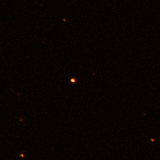
- GCN NOTICE
TITLE: GCN/SWIFT NOTICE
NOTICE_DATE: Tue 18 Apr 06 03:19:49 UT
NOTICE_TYPE: Swift-UVOT Processed Image
TRIGGER_NUM: 205851, Seg_Num: 0
POINT_RA: 236.443d {+15h 45m 46s} (J2000)
POINT_DEC: -3.634d {-03d 38' 01"} (J2000)
ROLL: 75.095d
IMG_START_DATE: 13843 TJD; 108 DOY; 06/04/18
IMG_START_TIME: 11360.87 SOD {03:09:20.87} UT, 192.7 [sec] since BAT Trigger Time
FILTER: 3, V
EXPOSURE_ID: 167022562
X_OFFSET: 707 [pixels]
Y_OFFSET: 947 [pixels]
WIDTH: 160 [pixels]
HEIGHT: 160 [pixels]
X_GRB_POS: 867
Y_GRB_POS: 1107
BINNING_INDEX: 1
IM_URL: sw00205851000msuni0192.fits
SUN_POSTN: 25.97d {+01h 43m 53s} +10.75d {+10d 44' 58"}
SUN_DIST: 148.89 [deg] Sun_angle= 10.0 [hr] (West of Sun)
MOON_POSTN: 258.71d {+17h 14m 50s} -28.17d {-28d 10' 28"}
MOON_DIST: 32.36 [deg]
MOON_ILLUM: 81 [%]
GAL_COORDS: 3.64, 37.91 [deg] galactic lon,lat of the pointing direction
ECL_COORDS: 235.01, 15.82 [deg] ecliptic lon,lat of the pointing direction
COMMENTS: SWIFT-UVOT Processed Image.
COMMENTS: The GRB Position came from the Window Position in the Mode Command.
COMMENTS: The image has 2x2 binning (compression).
COMMENTS: All 4 attachments are included.
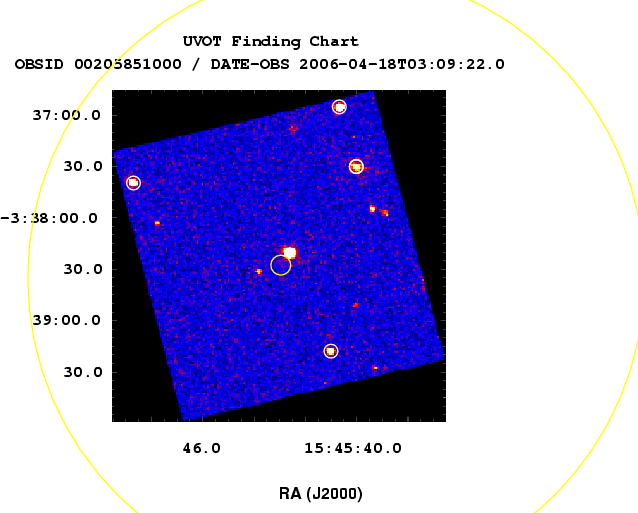
- GCN NOTICE
TITLE: GCN/SWIFT NOTICE
NOTICE_DATE: Tue 18 Apr 06 03:22:58 UT
NOTICE_TYPE: Swift-UVOT Source List
TRIGGER_NUM: 205851, Seg_Num: 0
POINT_RA: 236.443d {+15h 45m 46s} (J2000)
POINT_DEC: -3.634d {-03d 38' 01"} (J2000)
POINT_ROLL: 75.095d
IMG_START_DATE: 13843 TJD; 108 DOY; 06/04/18
IMG_START_TIME: 12038.17 SOD {03:20:38.17} UT, 870.0 [sec] since BAT Trigger Time
FILTER: 3, V
BKG_MEAN: 1.076
N_STARS: 29
X_OFFSET: 387 [pixels]
Y_OFFSET: 627 [pixels]
X_MAX: 1346 [pixels]
Y_MAX: 1586 [pixels]
DET_THRESH: 9
PHOTO_THRESH: 4
SL_URL: sw00205851000msufc0869.fits
SUN_POSTN: 25.97d {+01h 43m 53s} +10.75d {+10d 45' 01"}
SUN_DIST: 148.89 [deg] Sun_angle= 10.0 [hr] (West of Sun)
MOON_POSTN: 258.74d {+17h 14m 57s} -28.18d {-28d 10' 39"}
MOON_DIST: 32.38 [deg]
MOON_ILLUM: 81 [%]
GAL_COORDS: 3.64, 37.91 [deg] galactic lon,lat of the pointing direction
ECL_COORDS: 235.01, 15.82 [deg] ecliptic lon,lat of the pointing direction
COMMENTS: SWIFT-UVOT Source List.
- GCN NOTICE
TITLE: GCN/SWIFT NOTICE
NOTICE_DATE: Tue 18 Apr 06 03:23:45 UT
NOTICE_TYPE: Swift-UVOT Processed Source List
TRIGGER_NUM: 205851, Seg_Num: 0
POINT_RA: 236.443d {+15h 45m 46s} (J2000)
POINT_DEC: -3.634d {-03d 38' 01"} (J2000)
POINT_ROLL: 75.095d
IMG_START_DATE: 13843 TJD; 108 DOY; 06/04/18
IMG_START_TIME: 12038.17 SOD {03:20:38.17} UT, 870.0 [sec] since BAT Trigger Time
FILTER: 3, V
BKG_MEAN: 1.076
N_STARS: 29
X_OFFSET: 387 [pixels]
Y_OFFSET: 627 [pixels]
X_MAX: 1346 [pixels]
Y_MAX: 1586 [pixels]
DET_THRESH: 9
PHOTO_THRESH: 4
SL_URL: sw00205851000msufc0869.fits
SUN_POSTN: 25.97d {+01h 43m 54s} +10.75d {+10d 45' 01"}
SUN_DIST: 148.89 [deg] Sun_angle= 10.0 [hr] (West of Sun)
MOON_POSTN: 258.75d {+17h 14m 59s} -28.18d {-28d 10' 41"}
MOON_DIST: 32.39 [deg]
MOON_ILLUM: 81 [%]
GAL_COORDS: 3.64, 37.91 [deg] galactic lon,lat of the pointing direction
ECL_COORDS: 235.01, 15.82 [deg] ecliptic lon,lat of the pointing direction
COMMENTS: SWIFT-UVOT Processed Source List.
COMMENTS: All 4 attachments are included.
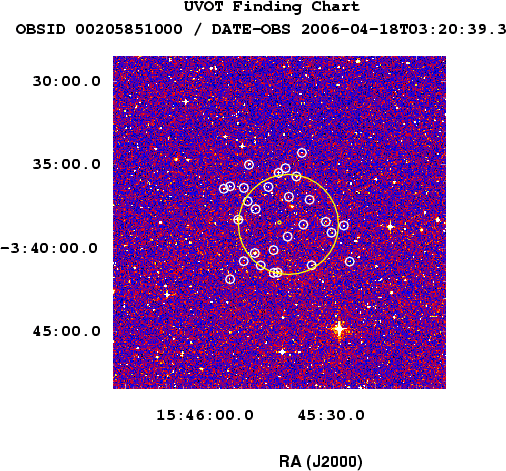
- GCN NOTICE
TITLE: GCN/SWIFT NOTICE
NOTICE_DATE: Tue 18 Apr 06 03:24:11 UT
NOTICE_TYPE: Swift-UVOT Image
TRIGGER_NUM: 205851, Seg_Num: 0
POINT_RA: 236.443d {+15h 45m 46s} (J2000)
POINT_DEC: -3.634d {-03d 38' 01"} (J2000)
ROLL: 75.095d
IMG_START_DATE: 13843 TJD; 108 DOY; 06/04/18
IMG_START_TIME: 12038.17 SOD {03:20:38.17} UT, 870.0 [sec] since BAT Trigger Time
FILTER: 3, V
EXPOSURE_ID: 167023239
X_OFFSET: 707 [pixels]
Y_OFFSET: 947 [pixels]
WIDTH: 160 [pixels]
HEIGHT: 160 [pixels]
X_GRB_POS: 867
Y_GRB_POS: 1107
BINNING_INDEX: 1
IM_URL: sw00205851000msuni0869.fits
SUN_POSTN: 25.97d {+01h 43m 54s} +10.75d {+10d 45' 02"}
SUN_DIST: 148.90 [deg] Sun_angle= 10.0 [hr] (West of Sun)
MOON_POSTN: 258.75d {+17h 15m 00s} -28.18d {-28d 10' 43"}
MOON_DIST: 32.39 [deg]
MOON_ILLUM: 81 [%]
GAL_COORDS: 3.64, 37.91 [deg] galactic lon,lat of the pointing direction
ECL_COORDS: 235.01, 15.82 [deg] ecliptic lon,lat of the pointing direction
COMMENTS: SWIFT-UVOT Image.
COMMENTS: The GRB Position came from the Window Position in the Mode Command.
COMMENTS: The image has 2x2 binning (compression).
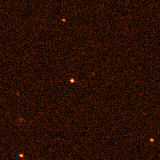
- GCN Circular #4966
A. D. Falcone (PSU), S. D. Barthelmy (GSFC), D. N. Burrows (PSU),
J. R. Cummings (NASA/ORAU), N. Gehrels (NASA/GSFC),
S. D. Hunsberger (PSU), J. A. Kennea (PSU) and D. M. Palmer (LANL)
report on behalf of the Swift Team:
At 03:06:08 UT, the Swift Burst Alert Telescope (BAT) triggered and
located GRB 060418 (trigger=205851). Swift slewed immediately to the burst.
The BAT on-board calculated location is
RA,Dec 236.420, -3.643 {15h 45m 41s, -03d 38' 35"} (J2000)
with an uncertainty of 3 arcmin (radius, 90% containment, including
systematic uncertainty). The BAT light curve shows a broad smooth peak
starting at T-8 sec. It decays almost to background, and then a bright
peak at T+27 sec (FWHM ~3 sec). There is possibly emission at T+130 sec.
The peak count rate was ~6000 counts/sec (15-350 keV), at ~27 sec
after the trigger.
The XRT began observing the field at 03:07:26 UT, 78 seconds after the
BAT trigger. XRT found a bright, variable, uncatalogued X-ray source
located at RA(J2000) = 15h 45m 42.8s, Dec(J2000) = -03d 38' 26.1",
with an estimated uncertainty of 5.8 arcseconds (90% confidence
radius). This location is 32 arcseconds from the BAT on-board
position, within the BAT error circle. The initial flux in the 0.1s
image was 1.6e-08 erg/cm2/s (0.2-10 keV).
UVOT took a finding chart exposure of 100 seconds with the White
(160-650 nm) filter starting 88 seconds after the BAT trigger. There
is a candidate afterglow in the rapidly available 2.7'x2.7' sub-image
at (RA,DEC) (J2000) of (236.4275,-3.6389) or
(15h45m42.60s,-03o38'20.0") with a 1-sigma error radius of about 0.5
arc sec. This position is 7.2 arc sec. from the center of the XRT
error circle. The estimated V magnitude is 14.5 with a 1-sigma error
of about 0.5 mag. No correction has been made for the expected
extinction corresponding to E(B-V) of 0.22.
- GCN NOTICE
TITLE: GCN/SWIFT NOTICE
NOTICE_DATE: Tue 18 Apr 06 03:25:22 UT
NOTICE_TYPE: Swift-UVOT Processed Image
TRIGGER_NUM: 205851, Seg_Num: 0
POINT_RA: 236.443d {+15h 45m 46s} (J2000)
POINT_DEC: -3.634d {-03d 38' 01"} (J2000)
ROLL: 75.095d
IMG_START_DATE: 13843 TJD; 108 DOY; 06/04/18
IMG_START_TIME: 12038.17 SOD {03:20:38.17} UT, 870.0 [sec] since BAT Trigger Time
FILTER: 3, V
EXPOSURE_ID: 167023239
X_OFFSET: 707 [pixels]
Y_OFFSET: 947 [pixels]
WIDTH: 160 [pixels]
HEIGHT: 160 [pixels]
X_GRB_POS: 867
Y_GRB_POS: 1107
BINNING_INDEX: 1
IM_URL: sw00205851000msuni0869.fits
SUN_POSTN: 25.97d {+01h 43m 54s} +10.75d {+10d 45' 03"}
SUN_DIST: 148.90 [deg] Sun_angle= 10.0 [hr] (West of Sun)
MOON_POSTN: 258.76d {+17h 15m 03s} -28.18d {-28d 10' 47"}
MOON_DIST: 32.40 [deg]
MOON_ILLUM: 81 [%]
GAL_COORDS: 3.64, 37.91 [deg] galactic lon,lat of the pointing direction
ECL_COORDS: 235.01, 15.82 [deg] ecliptic lon,lat of the pointing direction
COMMENTS: SWIFT-UVOT Processed Image.
COMMENTS: The GRB Position came from the Window Position in the Mode Command.
COMMENTS: The image has 2x2 binning (compression).
COMMENTS: All 4 attachments are included.
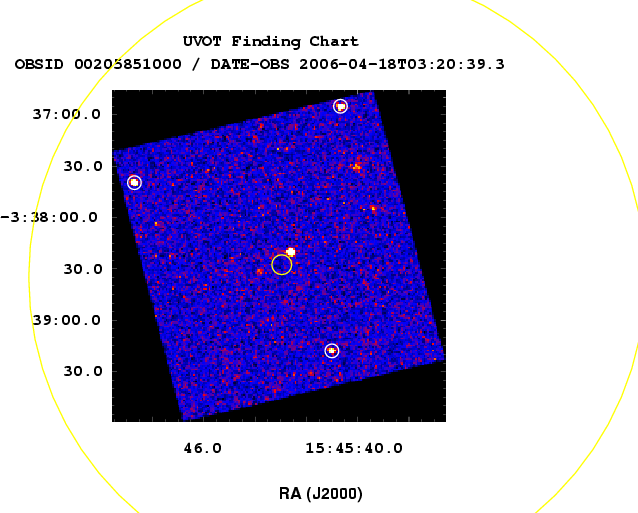
- GCN Circular #4967
S. Covino, L.A. Antonelli, E. Molinari, G. Chincarini, F.M. Zerbi, V.
Testa, G. Tosti, F. Vitali, P. Conconi, G. Cutispoto, G. Malaspina,
L. Nicastro, E. Palazzi, E. Meurs, P. Goldoni, report on behalf of
the REM/ROSS Team:
We imaged the field of GRB 060418 (Falcone et al. GCN 4966) with the
robotic 60-cm REM telescope located at La Silla (Chile). Observations
were performed automatically in the near infrared (J, H, K, z bands)
soon after the GRB alert.
We find a single bright source in the XRT error circle, not visible
in the 2MASS survey. Its H magnitude is about 11.25.
Further observations are still in progress.
This message is citeable.
- GCN Circular #4968
A. Melandri, A. Gomboc, C.G. Mundell, C. Guidorzi, A. Monfardini,
C.J. Mottram, R.J. Smith, I.A. Steele, D. Carter, M. Burgdorf,
S. Kobayashi, D. Bersier, M.F. Bode (Liverpool JMU) report:
"The 2-m Liverpool Telescope immediately observed the field of
GRB060418 (Falcone et al. 4966) and started observing its position
about 5.0 minutes after the GRB.
The automatic "detection mode" procedure clearly detected the
optical afterglow candidate at the XRT position reported by
Falcone et al. (GCN 4966).
This source has a R magnitude of ~14.0 after ~6 minutes from 3x10-s
images and clearly show a rapid early optical decay.
Further analysis and observation are still ongoing."
- GCN Circular #4969
A. K. Dupree, E. Falco (Harvard-Smithsonian CfA), J. X. Prochaska
(UCO/Lick Observatory), H.-W. Chen (U Chicago), and J. S. Bloom (UC
Berkeley) report on behalf of the GRAASP collaboration:
"We observed the afterglow of GRB060418 reported by Falcone et al. (GCN 4966)
using the MIKE echelle spectrograph on the Magellan Clay telescope with a
0.7-arcsec slit. The observations started at UT 03:34:02 on April 18, 2006,
~ 28 minutes after the inital Swift/BAT trigger. The first exposure had a
total integration of 1200 sec under a mean seeing condition of 0.4 arcsec.
The mean signal-to-noise of the single exposure was S/N > 20 over the entire
3500 Ang to 9000 Ang spectral coverage. We observed the strongest absorption
feaures at 6978 Ang and 6959 Ang, which we identify as the MgII absorption
doublet originated in the host of the GRB at z=1.49. We therefore adopt
this as the redshift of the GRB host due to the absense of any other
absorption features beyond 7100 Ang.
Further analysis is underway.
This message may be cited."
- GCN Circular #4970
B. E. Cobb (Yale), part of the larger SMARTS
consortium, reports:
Using the ANDICAM instrument on the 1.3m telescope at CTIO, we
obtained optical/IR imaging of the error region of GRB 060418
(Falcone et al. GCN 4966) beginning ~1 hours post-burst
(2006-04-18 04:05 UT). Several dithered images
were obtained in each filter, with total summed exposure times
of 180s in each of BRIYJK and 120s in each of H and V.
The afterglow candidate reported by Falcone et al. and
confirmed by Covino et al. (GCN 4967) and Melandri et al. (GCN 4968)
is visible in all wavebands, from B to K. At a mid-exposure
time of 1.2 hrs post-burst, the preliminary K-band magnitude
of the afterglow candidate is K = 14.1 +/- 0.1. This value is obtained
by comparison with nearby 2MASS standards. The lack of a Lyman-alpha
forest absorption break suggest this GRB has a redshift of z<~3.
- GCN Circular #4971
M. Nysewander, K. Ivarsen, A. Foster, D. Reichart, J. Haislip, A. LaCluyze,
A. Trotter, J. A. Crain, J. Kirschbrown, and C. MacLeod report on behalf of
the UNC team of the FUN GRB Collaboration:
Skynet observed the localization of GRB 060418 (Falcone et al., GCN 4966)
with one of the 16-inch PROMPT telescopes at CTIO beginning 40 sec after
the burst (15 sec after notification). We weakly detect the afterglow
(Falcone et al., GCN 4966) at z = 15.3 +/- 0.3 mag (calibrated to three
USNO-B1.0/NOMAD stars) in a 5-sec exposure taken at this time.
Observations were then interrupted until about 16 minutes after the burst
due to an unfortunately scheduled operating system update.
Skynet resumed observations with three of the PROMPT telescopes in Ugriz
(three simultaneously), with clear detections in 80-sec griz exposures.
At 16.6 minutes after the burst, we measure z = 14.44 +/- 0.02 mag,
implying a brightening of the afterglow at early times. At 1.3 hours after
the burst, we measure z = 16.2 +/- 0.1 mag. If fading as a power law
between these times, this implies a temporal index of about -1.1.
PROMPT is currently being built and commissioned.
- GCN Circular #4972
B. E. Cobb (Yale), part of the larger SMARTS consortium, reports:
Continuing ANDICAM observations (see GCN 4970 for observing details) of
the afterglow of GRB 060418 (Falcone et al. GCN 4966) record the steady
fading behavior of the afterglow between all 45-second individual I-band
exposures, as shown below. These preliminary magnitudes were
calibrated using several USNO-B1.0 stars and the error in the photometric
calibration is ~0.2 mag. The relative error is ~0.05 magnitudes.
time
post-burst I-magnitude
1.09 16.50
1.17 16.66
1.41 16.79
1.48 16.85
2.25 17.44
2.32 17.49
2.57 17.61
2.64 17.71
3.17 17.79 (225-second exposure)
3.34 17.99 (225-second exposure)
The decay rate is, therefore, approximately alpha = -1.2 between about 1
and 3 hours post-burst. This is similar to the power law index
calculated by Nysewander et al. (GCN 4971) during the first hour
post-burst and suggests that no jet break has yet been observed.
- GCN Circular #4973
A. D. Falcone, D. N. Burrows, Jamie Kennea (PSU), report on behalf of=20
the Swift XRT team:
Following the Malindi gap, we have analyzed the initial Swift XRT data
from GRB 060418 (Falcone et al., GCN4966), with a total exposure of 1.4=20
ks. The refined XRT position is:
RA(J2000) =3D 15 45 42.4
Dec(J2000) =3D -03 38 22.8
We estimate an uncertainty of 4 arcseconds radius (90% containment).
In addition to the afterglow decay, the early light curve has bright
flaring. The largest flare has a peak of about 460 c/s at approximately=20
128 s after the trigger time. Aside from the flaring, the light curve=20
is clearly fading, but the rate is difficult to estimate due to the=20
flaring and the limited data available at this time. A preliminary=20
estimate of the power law decay index is approximately 0.6 =B1 0.3.
This Circular is an official product of the Swift XRT Team.
- GCN Circular #4974
Paul Vreeswijk (U. of Chile/ESO) and Andreas Jaunsen (U. of Oslo)
report on behalf of a larger collaboration:
"Following the Swift detection of GRB060418 (Falcone et al., GCN
4966), we triggered observations with the Ultraviolet and Visual
Echelle Spectrograph (UVES), mounted at Kueyen (UT2) of ESO's Very
Large Telescope (VLT). The observations were performed using the
Rapid-Response Mode, which allows for robotic VLT observations without
any human intervention, except for the slit alignment. Starting at
3:16 UT (10min after the Swift/BAT trigger), a series of exposures
with increasing integration times (3, 5, 10, 20, and 40min) were
performed with central wavelengths 390nm in the blue arm and 564nm in
the red, covering 330-670nm at a resolving power of ~43000. This was
followed by a 90min exposure with central wavelengths 437nm in the
blue and 860nm in the red, extending the wavelength coverage up to
950nm.
A preliminary analysis of the spectra shows various absorption
features, which can be identified with typical metal lines originating
in at least four intervening absorbers at redshifts: z=0.602, z=0.655,
z=1.106 and the highest at z=1.489. This confirms the GRB060418
host-galaxy redshift determination by Dupree et al. (GCN 4969).
We are very grateful for the excellent support of the Paranal staff,
and in particular that of Stefano Bagnulo, Nancy Ageorges and Stan
Stefl."
- GCN Circular #4975
J. Cummings (GSFC/ORAU), L. Barbier (GSFC), S. Barthelmy (GSFC),
E. Fenimore (LANL), N. Gehrels (GSFC), D. Hullinger (UMD),
H. Krimm (GSFC/USRA), C. Markwardt (GSFC/UMD),D. Palmer (LANL),
A. Parsons (GSFC), T. Sakamoto (GSFC/ORAU), G. Sato (ISAS),
J. Tueller (GSFC), on behalf of the Swift-BAT team:
Using the data set from T-119 to T+183 sec from the recent telemetry
downlink, we report further analysis of BAT GRB 060418 (trigger #205851)
(Falcone, et al. GCN 4966). The BAT ground-calculated position
is RA,Dec = 236.428, -3.642 deg {15h 45m 42.6s, -3d 38' 31.5"} (J2000)
+- 0.8 arcmin, (radius, sys+stat, 90% containment). The partial coding was 30%.
The mask-weighted lightcurve shows three overlapping peaks - a slow rise
beginning at T-8 to a broad peak at T+10, a smaller peak at T+18, followed
by the largest spike at T+27. There is a small bump in the lightcurve at
T+130 which coincides with a flare seen in the XRT data.
(Falcone et al. GCN 4973). T90 (15-350 keV) is 52 +- 1 s.
The time-averaged spectrum from T-19.2 to T+136.6 is best fit by a
simple power-law model. The power law index of the time-averaged spectrum
is 1.66 +- 0.05. The fluence in the 15-150 keV band is 8.1 +- 0.2 x 10-06
erg/cm2. The 1-sec peak photon flux measured from T+27.45 sec in the
15-150 keV band is 6.7 +- 0.4 ph/cm2/sec.
Eiso is 5.3e+52 ergs in the 37.35 - 373.5 keV range at the GRB rest
frame using z = 1.49 (Dupree et al. GCN 4969, Vreeswijk et al. GCN 4974).
All the quoted errors are at the 90% confidence level.
- GCN Circular #4976
Martin Jel=EDnek (IAA Granada, Spain),
Petr Kub=E1nek (ISDC Versoix, Switzerland and ASU Ondrejov, Czech Rep.) and
Michael Prouza (Columbia University, USA and FZU Praha, Czech Rep.)
on behalf of the FRAM team, coordinated by FZU Praha, Czech Rep.
report:
The robotic telescope FRAM (part of the Pierre Auger
Observatory) located in Malargue, Argentina, observed the
Swift GRB 060418 (Falcone et al., GCN 4966) in fully automatic
mode (under control of RTS2), starting 51s after the GRB
trigger under thin cirrus. We detect the OT reported by UVOT
at 5 combined images (220s integration time) with mean
exposure time 3:11:12UT (~300s after the trigger) with R-band
magnitude 14.2+-0.2. We note, that our lightcurve seems to
peak at about this time - in agreement with observation of
PROMPT (Nysewander et al., GCN 4971).
- GCN Circular #4977
M. Koppelman (Starhouse Observatory and University of Minnesota) reports on
behalf of the AAVSO International High Energy Network on optical observations
of GRB060418 (GCN #4966, Falcone et al.) and its reported optical afterglow
(GCN #4968, Melandri et al.; GCN #4971, Nysewander et al.; GCN #4972, Cobb
et al.):
Koppelman reports the following Rc-band measurement:
03:46:20 UT Rc=16.47+/-0.14.
Rc magnitudes are untransformed and differential with respect to a
two-star ensemble with USNO B1.0 stars 0863-0300553 (R=14.86) and
0864-0294924 (R=14.22). Scatter in the check star was 0.05 mag. A
detailed report of these observations follows at the end of this report.
M. Nicholson (International Consortium of Robotic Astronomical Researchers)
reports V-band observations of this afterglow approximately three hours after
the burst. Analysis of these observations is continuing.
The AAVSO thanks the Curry Foundation for their continued support of the
AAVSO International High Energy Network.
Rc-band observations by M. Koppelman, Starhouse Observatory:
-----------------------
Name: Michael Koppelman
email: michael at aps.umn.edu
Observer: Michael Koppelman (KMP)
Site: Starhouse Observatory
Location: Cologne, MN
LatitudeLongitude: 45N 93W
Elevation: 800'
Scope: Newtonian 0.212m
ScopeFocalRatio: f/3.9
CCDVendor: SBIG ST-7XME
CCDDetector: Kodak KAF-0402ME
CCDSize: 765x510
CCDPixelScale: 2.26"/px
CCDFOV: 30x20
Object: GRB060418A
ObsDate: 2006-04-18
ObsMidPointTime: 2006-04-18 03:46:22
TimePerFrame: 60, 120 and 180s
NumberOfFrames: 10
Filters: Rc
Processing: bias, dark, flat
Seeing:
LimitingMag:
Sky: Good
afterglowmag: 16.47
afterglowerr: 0.14
compstars: B1.0 0863-0300553 and 0864-0294924
Report: I observed the afterglow at high air mass (~5) with an Rc filter.
Plate solution yields a position of 15:45:42.54 -03:38:21 with an error
of about 1". The afterglow is visible on 1 of 10 images but reliably
detected above the sky background on 2 other images for a total of 3
positive detections.
JD Rc Err
2453843.6530 16.44 0.39
2453843.6600 16.57 0.22
2453843.6621 16.37 0.22
Rc magnitudes are untransformed and differential with respect to a
two-star ensemble with USNO B1.0 stars 0863-0300553 (R=14.86) and
0864-0294924 (R=14.22). Scatter in check star was 0.05m.
Fits images and photometry available upon request to michael at aps.umn.edu.
- GCN Circular #4978
P. Schady (UCL-MSSL), A. D. Falcone (PSU), report on behalf of the Swift/UVOT
team:
The Swift/UVOT began taking data on the field of GRB060418 at
2006-04-18T03:07:36, 88 s after the BAT trigger (Falcone et al., GCN 4966). The
source is observed to decay in six of the UVOT filters, but was not detected in
the UVW2 filter down to a 3-sigma limiting magnitude of UVW2 > 20.4 in a 949s
coadded image. This is consistent with the reported redshift of z=1.49 (Dupree
et al. 2006; GCN 4969). The magnitudes for the filters in which there was a
detection are as follows:
Filter T_mid(s) Exp(s) Mag
V 393 393 14.99 +/- 0.02
5996 197 18.84 +/- 0.33
B 675 10 16.22 +/- 0.13
10765 295 19.87 +/- 0.27
U 656 20 15.83 +/- 0.09
6610 197 18.55 +/- 0.20
UVW1 632 20 16.47 +/- 0.19
6405 197 19.04 +/- 0.40
UVM2 608 20 17.30 +/- 0.30
4343 197 > 19.30
White 137 10 14.32 +/- 0.03
11676 295 19.23 +/- 0.16
These magnitudes are uncorrected for the estimated Galactic
reddening of E_{B-V} = 0.224 mag (Schlegel et al. 1998).
- GCN Circular #4979
A. Henden (AAVSO) reports on behalf of the AAVSO
High Energy Network and Sonoita Research Observatory (SRO):
We have acquired BVRcIc all-sky photometry for a 20x20arcmin
field centered on the coordinates of the afterglow for
GRB060418 (Falcone et al. GCN 4966) with the SRO 0.35m telescope
on one marginally photometric night. The current zeropoint
error is approximately 0.04mag and will be improved with
additional nights of photometry. As opposed to previous
calibrations, this one is quite shallow, saturating at
about V=11. Further reductions will extend this calibration
about two magnitudes fainter.
We have placed the photometric data on our anonymous ftp site:
ftp://ftp.aavso.org/public/grb/grb060418.dat
Note#1: the USNO-FS ftp site (ftp.nofs.navy.mil) that used
to contain all of the calibrations by Henden had a hard disk
failure about a month ago. All of the calibrations have been
moved to the AAVSO site, where they will be maintained for
the forseeable future.
Note#2: the grb060418 file has a modified format that includes
(V-Ic). This will be the format for subsequent calibrations.
As always, you should check the dates on the .dat file prior to
final publication to get the latest photometry. There is
a README file on the ftp directory to give you information
about the procedures used to calibrate these fields.
- GCN Circular #4980
A. M. Soderberg (Caltech) and D. A. Frail (NRAO) report:
"Using the Very Large Array, we observed the field of GRB 060418 (GCN
4966) at 8.5 GHz on Apr 19.50 UT. We detect no source above our detection
limit of 78 uJy (2-sigma) at the position of the X-ray/optical afterglow
(GCN 4966).
The National Radio Astronomy Observatory is a facility of the National
Science Foundation operated under cooperative agreement by Associated
Universities, Inc."
- GCN Circular #4981
Daniel Kocevski, J. S. Bloom (UC Berkeley), and C. H. Blake (Harvard/
CfA), on behalf of a larger collaboration, report:
"We began observations of GRB 060417 (Falcone et. al. GCN 4966) with
the PAIRITEL 1.3m at 2006-04-18 05:25:34. UTC, 2hr32min after the GRB
trigger. The transient reported by Falcone et al. (GCN 4966) is well
detected in 300s mosaics simultaneously in JHKs bands, and is seen to
fade between mosaics. A series of 13 simultaneous JHKs mosaics taken
over 6 hours of observations shows a power law decline in J with a
slope of about alpha = 1.11 +/- 0.10 ( F(t)~t^(-alpha) ). The decay
slopes measured in H and Ks are consistent with the J band slope
within error. This slope is consistent with that reported by
Nysewander et al. (GCN 4971) and Cobb et al. (GCN 4972). No break
was seen in the observed decay out to at least 08:09:31 UTC.
An animated gif of the observations can be found at:
http://lyra.berkeley.edu/~kocevski/GCN/GRB060418.gif
This message may be cited.
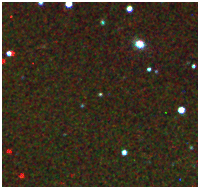
- GCN Circular #4982
B.A. Chen (NCKU), C.S. Lin, K.Y. Huang, W.H. Ip (NCU),
Y. Urata (Saitama-U) on behalf of EAFON report:
"We have made B, R, I band imaging for GRB 060418 optical afterglow
(Falcone et al. GCN 4966) using Lulin 1m telescope started from
14:38 (UT) on April 18. Preliminary our photometry is below.
=================================
Delay(d) Filter mag.
---------------------------------
0.496 R 20.7 +/- 0.1
=================================
This message may be cited."
- GCN Circular #4983
K. Y. Huang, W.H. Ip(NCU), Y. Urata (Saitama-U)
on behalf of EAFON report:
" We performed IR follow-up observations with CFHT/WIRCam from 8 hours
after the GRB. The afterglow was detected in JHKs bands clearly. The
afterglow brightness estimated from 2MASS catalog is Ks = 16.8 +/-0.1
at 8.11 hours after the burst. During our observational period, the
decay index is about 1 in Ks band. "
This message may be cited.
- GCN Circular #4984
K. Y. Huang, W.H. Ip(NCU), Y. Urata (Saitama-U)
on behalf of EAFON report:
The report of GCN 4983 is for "GRB 060418". Below is correct one.
GRB 060418 : IR afterglow observations
" We have performed IR follow-up observations for GRB 060418 (Falcone
et al. GCN 4966) with CFHT/WIRCam at 8 hours after the GRB. The
afterglow was detected in JHKs bands clearly. The afterglow
brightness estimated from 2MASS catalog is Ks = 16.8 +/-0.1 at 8.11
hours after the burst. During our observational period, the decay
index is about 1 in Ks band. "
- GCN Circular #4989
S. Golenetskii, R.Aptekar, E. Mazets, V. Pal'shin, D. Frederiks, M.
Ulanov, and
T. Cline on behalf of the Konus-Wind team report:
The long GRB 060418 (Swift-BAT trigger=205851; Falcone et al. GCN 4966;
Cummings et al. GCN 4975) was observed by Konus-Wind in the waiting
mode. The emission is clearly seen in the three K-W bands:
G1 (18-70 keV), G2 (70-360 keV) and G3 (360-1360 keV) with high S/N.
Using an approximation the time-integrated 3-channel K-W spectrum by
a power law with exponential cutoff model:
dN/dE ~ E^(-alpha)*exp(-E*(2-alpha)/Ep),
we have found alpha ~1.5, and Ep ~230 keV.
As observed by Konus-Wind, the burst had a duration of ~44 s,
and fluence ~1.6x10^-5 erg/cm2 (in the 20 - 1100 keV energy range).
Assuming z = 1.49 (Dupree et al. GCN 4969; Vreeswijk and Jaunsen GCN
4974) and a standard cosmology model with H_0 = 70 km/s/Mpc, Omega_M =
0.3, Omega_\Lambda = 0.7, the isotropic energy release is E_iso ~9x10^52
erg.
~1200 s after the BAT GRB 060418, Konus-Wind detected another burst.
Whether the second event relates to the first GRB or whether it is a
different
GRB detected by chance close to first one is not clear at this time.
The available data cannot confirm or rule out the possibility that the
second event came from the same location as the Swift GRB:
a) the Konus-Wind ecliptic latitude response for the second event is
consistent with the ecliptic latitude response for the Swift GRB.
b) BAT does not see a rate increase at ~03:26. At this time, GRB 060418
was out of the BAT FOV (~57 degrees off axis), but a little above the
Earth horizon (J. Cummings, private communication). So, the BAT data do
not rule out the possibility the second event came from GRB 060418.
c) Neither burst was detected by Odyssey, but both bursts are Mars-blocked,
if the second one comes from the same direction as the first. RHESSI
observed the first (Swift) burst, but not the second one. The RHESSI
detection of the first burst was rather weak, and as observed by
Konus, the second burst was weaker than the first one, so it could have
missed.
the second one (K. Hurley, private communication).
d) The second event was not detected by Suzaku-WAM. The position of GRB
060418 was occulted by the Earth from Suzaku at the time of the second
event (K. Yamaoka, private communication).
Hence, the situation is ambiguous.
Possibly, the data from optical telescopes can clarify this issue, if
there were some optical observations of the GRB 060418 afterglow during
the time of the second event.
The K-W light curves of these events are available at
http://www.ioffe.rssi.ru/LEA/GRBs/GRB060418/
- GCN Circular #4990
B. Hafizov (MAO), D. Sharapov (MAO and NOT, La Palma), A. Pozanenko
(IKI), M. Ibrahimov (MAO) on behalf of larger GRB follow up collaboration
report:
We observed the afterglow of GRB060418 (Falcone et al. GCN 4966) with 1.5m
telescope of Maidanak Astronomical Observatory (MAO) in BRI-bands on April
18. A series of BRI images (B: 8x180s, R: 7x120s, I: 9x120s) were taken on
April 18 (UT) 19:54 - 21:07 and 9x120s I-images were taken between
22:14 - 22:37. We detect OT (Falcone et al. GCN 4966) on single images in I
and R; preliminary OT brightness estimation of the first I-image
(UT=19:54) is ~20.5. Data reduction is continuing.
This message may be cited.
- GCN Circular #4991
G. Ghisellini, G. Ghirlanda and F. Tavecchio report:
The long GRB 060418 detected by Swift (Falcone et al. GCN 4966;
Cummings et al. GCN 4975) whose spectral parameters have been reported
by Golenetskii et al. (GCN 4989), as observed by Konus-Wind, is
consistent with the E_peak-E_iso (Amati) correlation. If the light
curve will show a break at t=3+-1 days, this burst would also be
consistent with the E_p-E_gamma (Ghirlanda) relation. Therefore
multiwavelength observations are encouraged.
This message may be cited.
- GCN Circular #5002
J. X. Prochaska (UCO/Lick Observatory), H.-W. Chen (U Chicago), J. S.
Bloom (UC
Berkeley), E. Falco, and A. K. Dupree (Harvard-Smithsonian CfA)
report on behalf of the
GRAASP collaboration:
"We have further analyzed the echelle spectra of GRB060418 (Falcone
et al.
GCN 4966), obtained using MIKE on the Magellan Clay telescope (Dupree
et al.
GCN 4969). We report the detection of ZnII, SiII, SiII*, FeII, FeII*,
MgII, MgI, AlIII, CIV and NiII transitions among others at a redshift
z=1.4901 +/- 0.0001. The relative populations of the excited
FeII levels are similar to GRB051111 (PHB06, astro-ph/0601057); the
J=7/2 to
J=1/2 states follow a Boltzmann distribution with T=1000-5000K.
But, following GRB051111 and GRB050730, we interpret the FeII excitation
as the result of indirect UV pumping by the GRB afterglow. The
detection
of strong MgI absorption places this gas (and presumably the majority of
low-ion gas) at a distance r>50pc from the GRB. Finally, we measure
[Si/Fe]=+0.5dex indicating a modest dust-to-metals ratio.
This message may be cited."
- GCN Circular #5009
A. D. Falcone, D. N. Burrows, D. Morris, J. Racusin (PSU), P. T.
O'Brien, J. P. Osborne (U Leicester), N. Gehrels (GSFC) report on behalf
of the Swift XRT team:
We have performed more analysis on recent Swift XRT data from GRB 060418
(Falcone et al., GCN4966). As reported by Falcone et al. (GCN4973), the
early afterglow decay has bright flaring. This flaring made it
difficult to estimate the afterglow decay index at the time of the
previous report, which made use of only the initial flare-dominated
data. Here we give a better estimate of this decay, along with some
preliminary spectral information.
From 78 s until about 115 s after the burst trigger time, the light
curve had a steep power law decay index of alpha =3D 4.6 +/- 0.2. A large
flare begins at T+115 s, peaking at T+135 s (where T is the BAT trigger
time) with a maximum count rate of ~560 c/s. Flaring continues to at
least T+6000 s. No flares are evident after T+40,000 s, at which point
the count rate has dropped to less than 0.01 c/s. The temporal decay of
the underlying afterglow was fit using two time regions that showed no
evidence of flaring (T+350 to T+530 s, and T+40,000 to T+190,000 s).
The underlying afterglow has a power law decay index of alpha =3D 1.4 =B1
0.1 from T+350 s until the last detection at T+700,000 s. There is no
evidence for a break in the underlying decay curve up to 9 days after
the trigger. In particular, we do not detect the break predicted by
Ghisellini et al. (GCN 4991), although we have only a single 2 sigma
data point after the predicted break time. Due to a normal orbital gap,
we have no data during the time of the potential second burst reported
by Konus-Wind (Golenetskii et al. GCN4989).
A preliminary light curve can be viewed at
http://www.astro.psu.edu/users/afalcone/grb060418/falcone_grb060418.gif
The observed spectra of the underlying afterglow can be described by a
simple absorbed power law, with photon index 2.04 +/- 0.13 and total N_H
=3D (19 +/- 4)e20 cm^-2, with a chi2/dof of 1.22 (75 dof). This fit
assumes all absorption is local to the observer. The Galactic N_H at
this position is ~9e20 cm^-2 (Dickey and Lockman 1990). We fit the time
period during the large flare with a spectral model that was the sum of
two power laws; one was the underlying afterglow frozen to the values
shown above (with the normalization changed based on the measured
temporal decay) and the other was a power law that was free to vary.
This fit resulted in a chi2/dof of 1.07 (321 dof), with the following
flare power law component parameters: photon index 2.04 +/- 0.05 and N_H
= (29 +/-2)e20 cm^-2. For the flare component, we also tried a cutoff
power law, a Band function, and a blackbody model. In all cases, the
fits were equivalently acceptable, with chi2/dof always falling in the
range from 1.05 to 1.07. The cutoff power law was equivalent to the
simple power law since the cutoff reached a maximum value in excess of
500 keV. The Band function and the blackbody models both resulted in
harder energy spectral indices, with an N_H that was consistent (within
1 sigma error bars) with that of the underlying afterglow. This is in
contrast to the simple power law that implies an N_H increase during the
flare (relative to the underlying afterglow value).
This Circular is an official product of the Swift XRT Team.
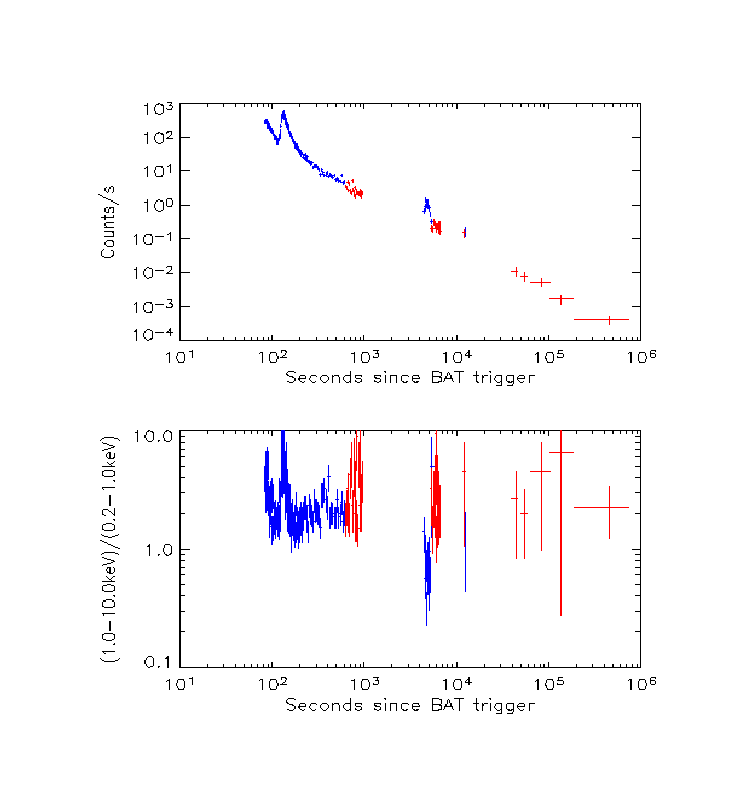
- GCN Circular #5112
R. Karimov, B. Hafizov (MAO), A. Pozanenko (IKI), M. Ibrahimov (MAO) on
behalf of larger GRB follow up collaboration report:
We observed the afterglow of GRB060418 (Falcone et al. GCN 4966) with 1.5m
telescope of Maidanak Astronomical Observatory (MAO) in BRI-bands on April
18 between (UT) 19:54 and 22:37 (Hafizov et al. GCN 4990). A photometry
of the afterglow is following:
Mid_Time(UT), Filter, Exposure, Magnitude
18.857 B 7x180 s 22.38 +/- 0.10
18.853 R 7x120 s 21.14 +/- 0.05
18.855 I 9x120 s 20.66 +/- 0.04
18.934 I 9x120 s 20.35 +/- 0.04
The photometry is based on field stars calibration by Henden (GCN 4979) and
not corrected for Galaxy extinction. We note our I-observations indicate a
possible re-brighntening of the afterglow.
This message may be cited.
- astro-ph/0701688 from 24 Jan 2007
Vergani: REM observations of GRB 060418: the fireball Lorentz factor determination
We measured the fireball Lorentz factor of GRB 060418 by the direct
observation of the onset of the NIR afterglow carried with the REM telescope.
We found a value of about 400.
- astro-ph/0701715 from 25 Jan 2007
Jin: GRB 060418 and 060607A: the medium surrounding the progenitor and the weak reverse shock emission
We constrain the circum-burst medium profile with the rise behavior of the
very early afterglow light curves of gamma-ray bursts (GRBs). Using this
method, we find a constant and low-density medium profile for GRB 060418 and
GRB 060607A, which is consistent with the inference from the late afterglow
data. In addition, we show that the absence of the IR flashes in these two GRB
afterglows is consistent with the standard external reverse shock model, which
thus renders models like the highly magnetized GRB outflow being unnecessary to
a certain extent.
- 0710.0727from 3 Oct 2007
Covino: The afterglow onset for GRB060418 and GRB060607A
Abstract: Gamma-ray burst are thought to be produced by highly relativistic outflows.
Although upper and lower limits for the outflow initial Lorentz factor
$\Gamma_0$ are available, observational efforts to derive a direct
determination of $\Gamma_0$ have so far failed or provided ambiguous results.
As a matter of fact, the shape of the early-time afterglow light curve is
strongly sensitive on $\Gamma_0$ which determines the time of the afterglow
peak, i.e. when the outflow and the shocked circumburst material share a
comparable amount of energy. We now comment early-time observations of the
near-infrared afterglows of GRB 060418 and GRB 060607A performed by the REM
robotic telescope. For both events, the afterglow peak was singled out and
allowed us to determine the initial fireball Lorentz, $\Gamma_0\sim 400$.
- 1110.0487 from 5 Oct 11
Hsiao-Wen Chen: Near-infrared Spectroscopy of GRB Host Galaxies at z >~ 1.5: Insights into Host Galaxy Dynamics and Interpretations of Afterglow
Absorption Spectra
This paper presents near-infrared echellette spectra of faint galaxies in the fields around GRB 050820A at redshift z=2.613 and GRB 060418 at
z=1.490. The spectroscopic data show that both GRBs originate in a dynamic environment of interacting galaxies separated by < 15 h^{-1} kpc in
projected distance and |dv| <~ 60 km/s in line-of-sight velocity. The optical afterglows revealed in early-epoch Hubble Space Telescope images
are at least 2.5 h^{-1} kpc (or 0.4") away from the high surface brightness regions of the interacting members, indicating that the GRB events
occurred either in the outskirts of a compact star-forming galaxy or in a low surface brightness satellite. Comparisons of the systemic
redshifts of the host galaxies and the velocity distribution of absorbing clouds revealed in early-time afterglow spectra further show that the
majority of the absorbing clouds are redshifted from these compact star-forming galaxies. These include the gas producing fine-structure
absorption lines at physical distances d ~ a few x 100 pc from the GRB afterglow. The lack of blueshifted absorbing clouds and the spatial
offset of the GRB event from the star-forming regions make it difficult to attribute the observed large velocity spread (~ 200-400 km/s) of
absorbing gas in the GRB host to galactic-scale outflows. We consider a scenario in which the GRB event occurred in a dwarf satellite of the
interacting group and interpret the broad absorption signatures in the afterglow spectra as a collective effect of the turbulent halo gas and
the host star-forming ISM. We briefly discuss the implications for the absorption properties observed in the afterglow spectra.
![]() Previous IAU Circulars
Previous IAU Circulars 













